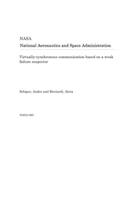
Virtually-Synchronous Communication Based on a Weak Failure Suspector
Series:
Failure detectors (or, more accurately Failure Suspectors (FS)) appear to be a fundamental service upon which to build fault-tolerant, distributed applications. This paper shows that a FS with very weak semantics (i.e., that delivers failure and recovery information in no specific order) suffices to implement virtually-synchronous communication (VSC) in an asynchronous system subject to process cr
NaN
VOLUME
English
Paperback

Failure detectors (or, more accurately Failure Suspectors (FS)) appear to be a fundamental service upon which to build fault-tolerant, distributed applications. This paper shows that a FS with very weak semantics (i.e., that delivers failure and recovery information in no specific order) suffices to implement virtually-synchronous communication (VSC) in an asynchronous system subject to process crash failures and network partitions. The VSC paradigm is particularly useful in asynchronous systems and greatly simplifies building fault-tolerant applications that mask failures by replicating processes. We suggest a three-component architecture to implement virtually-synchronous communication: (1) at the lowest level, the FS component; (2) on top of it, a component (2a) that defines new views; and (3) a component (2b) that reliably multicasts messages within a view. The issues covered in this paper also lead to a better understanding of the various membership service semantics proposed in recent literature. Schiper, Andre and Ricciardi, Aleta Unspecified Center NAG2-593...
Price Comparison [India]
In This Series
Bestseller Manga
Trending NEWS




















